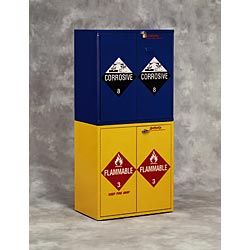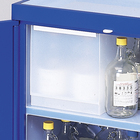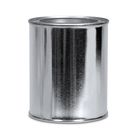How to Store Chemicals
By Bruce Wilson
You have chosen experiments to wow your incoming classes and start their school year with a metaphorical bang. If those experiments involve chemicals and you are responsible for their storage, now is a good time to review or implement your chemical storage system. Setting up a safe chemical storage system is both simple and critical.
There are 5 classes of chemicals: general storage, flammable, toxic, reactive, and corrosive. Each chemical's class is indicated by color on the container's label. The following list indicates the classes of chemicals and their colors:
- General storage (green)
- Flammable (red)
- Toxic (blue)
- Reactive (yellow)
- Corrosive (white)
As a general rule, chemicals of the same class may be stored together safely. Any system has its exceptions, though. For example, even though acids and bases are both classed as corrosives, they should be stored separately as subclasses. Nitric acid is another exception and should be stored in its own shallow plastic tray separate from all other chemicals. Other chemicals may require special handling. Review each chemical's Safety Data Sheet (SDS) for details.
As you segregate your chemicals, assess the condition of each container. Transfer the contents from a failed or failing container to a new container, label it appropriately and securely close it. Identify any chemicals for disposal and notify appropriate school personnel to arrange pickup, or consider asking other teachers in your school or district whether they can use them. A good rule of thumb is, “If you don’t plan to use it, lose it.”
After segregating the chemicals by class, consider where to store the classes. For corrosives and flammables, we offer a variety of specially designed, lockable safety cabinets. We recommend that corrosives not be stored in metal cabinets. The cabinets shown here are heavy-duty plywood.

Figure 1 Corrosives and flammables safety cabinets.
We recommend that the other 3 chemical classes also be stored in cabinets of their own. When stored in a cabinet, the chemicals are less likely to be knocked over than when stored on a shelf. Also, cabinet locks provide an extra layer of security. If space or budget does not allow for additional cabinets, the reactives, toxics, and general storage chemicals may be safely segregated on shelves. In that case, we recommend that you group containers of like chemicals inside plastic trays to contain any spill that may occur from a failed container.
Before you consider your storage job complete, be sure that an SDS for every substance in your inventory are readily available to anyone using the stockroom. Share their location with other science department staff and your administration. If you need an SDS for any chemical that Carolina offers, you can find it here. In addition, prepare and maintain an accurate list of everyone with access to the chemical storage area for you and for your school’s administration. Only authorized staff should access the chemical storage area.








